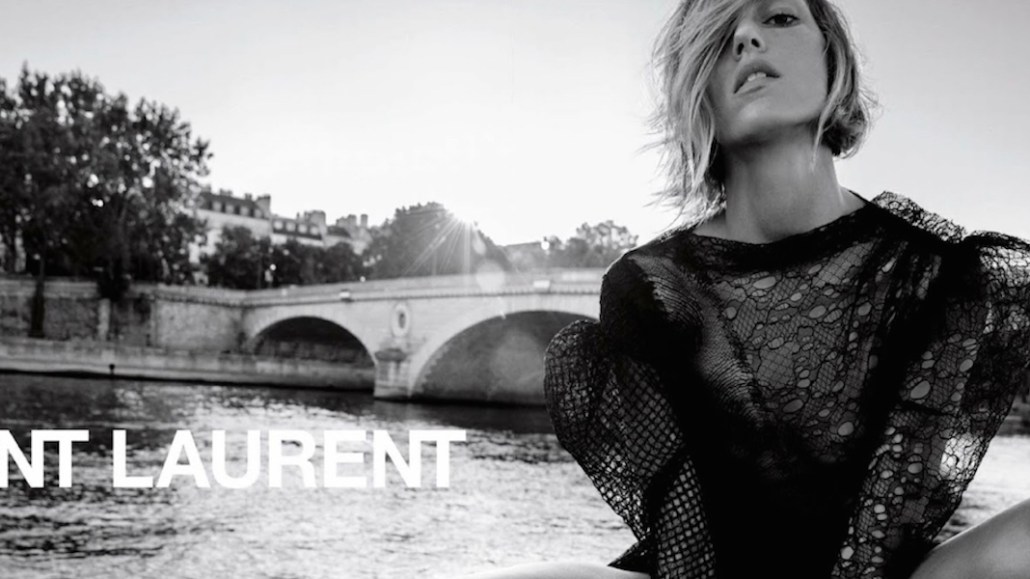Kering wants to double revenue at Saint Laurent, its second-strongest brand


Kering has big plans for the future of Saint Laurent, its second-highest performing fashion brand after Gucci: It has a goal of doubling revenue and hitting $2.2 billion in sales by 2021, and the company is looking to ride the brand’s resonance with millennials to do so.
At an investor day this week, Kering disclosed the demographic breakdown of the brand, which is currently led by former Versus Versace designer Anthony Vaccarello. Women between the ages of 18 and 34 account for 65 percent of sales, while women between 25 and 34 account for 52 percent of sales.
In a recent call with investors, Kering CEO Francois-Henri Pinault spoke to how the house is adjusting itself to align better with new consumer behavior.
“Customers’ consumption patterns are changing completely. They have a wealth of information, and they can prepare before they come into shops. A third of customers will visit us online or on social before they go into a boutique,” he said. “Millennials represent half of sales for Gucci and Saint Laurent, and they are looking for meaning. In this environment, established brands benefit from the support of a big group, given the obvious competitive edge.”
Kering has empowered the functionality of its individual brand sites over the past several years, citing e-commerce and cross-channel capabilities as a top business priority. For Saint Laurent, that plays out online in the shape of a minimalist, easy-to-navigate site that emphasizes strong photography and video on all its pages, as well as free shipping. While Kering doesn’t break out online sales, it reported in the first quarter of 2017 that online sales were boosted by growth in North America and Western Europe.
To drive toward its hefty goal of doubling its revenue, Saint Laurent plans to also double its digital marketing spend this year. Right now, only 22 percent of its marketing budget goes toward social media. Last year, when Vaccarello took over as creative director from Hedi Slimane, the brand, which hadn’t been that active on Instagram to begin with, deleted what was on its feed in order to start over. The brand now has 2.2 million followers on the platform, with its posts revolving around campaigns and new collections.
Ad position: web_incontent_pos1
“Saint Laurent’s collections under Vaccarello were different, but they were part and parcel to a new stylistic framework,” said Pinault to investors. “Tomorrow’s luxury isn’t based on heritage and artisanal excellence. There must be creativity. We have a modern vision of luxury based on strong creative content and codes that will last overtime.”
This mindset supports the overall growth Kering has seen in the past year, driven by explosive growth at Gucci and steady growth at Saint Laurent. In the first quarter of 2017, Kering’s overall sales grew by 31 percent. (At Gucci, revenue was up 51 percent; it was up 35 percent at Saint Laurent.)
“Kering has always excelled at balancing omnichannel well,” said Jian DeLeon, Highsnobiety’s editorial director. “They’re building brand awareness online, while staying exclusive.”
In order to reach its goal of hitting $2.2 billion in sales by 2021, however, Kering has plans to open more Saint Laurent stores. Right now, the brand has 159 global stores, and it plans to boost that to 200 in the next four years to reach new audiences globally. The move is to capitalize on the direct-to-consumer retail growth the brand has seen: It now accounts for 68 percent of sales, up from 60 percent in 2012, while wholesale currently accounts for 27 percent.
“Both the Gucci and YSL brands are extremely strong right now, so having robust destinations for these brands is critical,” said Robert Burke, CEO of Robert Burke Associates, in a previous Glossy interview. “The brand awareness is there. People are seeking it out.”
More in Marketing

In the marketing world, anime is following in the footsteps of gaming
As marketers look to take advantage of anime’s entry into the zeitgeist, they might be wise to observe the parallels between the evolution of anime as a marketing channel and the ways brands have learned to better leverage gaming in recent years.

With the introduction of video ads and e-commerce, Roblox looks to attain platform status
Roblox is expanding into more areas than just ads in 2024. Much like platforms such as Amazon and Facebook have transcended their origins to evolve from their origins as online marketplaces and social media channels, Roblox is in the midst of a transformation into a platform for all elements of users’ virtual lives.

PepsiCo wants to remain a ‘driver of culture’ as it turns to influencers and activations amid rebrand
The soda-maker says it can translate cultural relevance into sales volume.
Ad position: web_bfu



